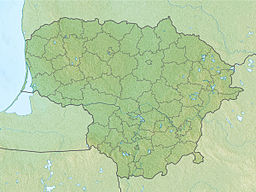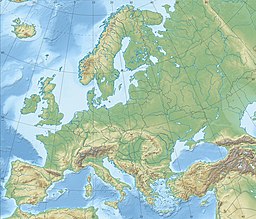| Revision as of 13:53, 21 January 2023 editMarcin 303 (talk | contribs)Extended confirmed users19,288 editsNo edit summary← Previous edit | Latest revision as of 18:58, 26 October 2024 edit undoMonkbot (talk | contribs)Bots3,695,952 editsm Task 20: replace {lang-??} templates with {langx|??} ‹See Tfd› (Replaced 3);Tag: AWB | ||
| (11 intermediate revisions by 10 users not shown) | |||
| Line 2: | Line 2: | ||
| {{Infobox body of water | {{Infobox body of water | ||
| | name = Curonian Lagoon | | name = Curonian Lagoon | ||
| | native_name = {{Native name|lt|Kuršių marios}} | | native_name = {{Native name list|tag1=lt|name1=Kuršių marios|tag2=ru|name2=Куршский залив}} | ||
| | image = Curonian Spit and Lagoon.png | | image = Curonian Spit and Lagoon.png | ||
| | caption = Map of the ] and Lagoon | | caption = Map of the ] and Lagoon | ||
| Line 12: | Line 12: | ||
| | width = {{convert|46|km|abbr=on}} | | width = {{convert|46|km|abbr=on}} | ||
| | area = {{convert|1,619|km2|abbr=on}} | | area = {{convert|1,619|km2|abbr=on}} | ||
| | |
| depth = {{convert|3.8|m|abbr=on}} | ||
| | max-depth = {{convert|5.8|m|abbr=on}} | |||
| | cities = | | cities = | ||
| | pushpin_map = Lithuania#Baltic Sea#Europe | | pushpin_map = Lithuania#Baltic Sea#Europe | ||
| }} | }} | ||
| The '''Curonian Lagoon''' (or Bay, Gulf; |
The '''Curonian Lagoon''' (or Bay, Gulf; ]: ''Kursjanmari'', {{langx|lt|Kuršių marios}}, {{langx|ru|Куршский залив}}) is a ] ] separated from the ] by the ]. Its surface area is {{convert|1,619|km2|sqmi|sp=us}}.<ref>{{cite web|publisher=]|url=http://www.britannica.com/EBchecked/topic/140578/Curonian-Lagoon|title=Curonian Lagoon|accessdate=2009-10-17}}</ref> The ] ({{langx|lt|Nemunas}}) supplies about 90% of its inflows; its watershed consists of about 100,450 square kilometres in ] and Russia's ].<ref name=sus>{{cite book|title=Sustainable Use and Development of Watersheds|publisher=]|author=I. Ethem Gönenç, Angheluta Vadineanu|url=https://books.google.com/books?id=s1SmQ5TYB6YC&q=Curonian+Lagoon+watershed&pg=PA404|year=2008 | isbn=978-1-4020-8557-4}}</ref> | ||
| ==Human history== | ==Human history== | ||
| ] | ]'s Landsat satellite image of Curonian Lagoon]] | ||
| In the 13th century, the area around the lagoon was part of the ancestral lands of the ] and ]. Later it bordered the historical region of ]. At the northern end of the Spit, the ] connects the lagoon to the ], and the place was chosen by the ] in 1252 to found |
In the ], the area around the lagoon was part of the ancestral lands of the ] and ]. Later it bordered the historical region of ]. At the northern end of the Spit, the ] connects the lagoon to the ], and the place was chosen by the ] in 1252 to found ] and the city of ]. In 1454, King ] incorporated the region to the ] upon the request of the anti-Teutonic ].<ref>{{Cite book|last=Górski|first=Karol|title=Związek Pruski i poddanie się Prus Polsce: zbiór tekstów źródłowych|year=1949|publisher=Instytut Zachodni|location=]|language=pl|page=54}}</ref> Following the ], the lagoon became a part of Poland as a ] held by the Teutonic Knights,<ref>Górski, pp. 96–97, 214–215</ref> and thus located within the ], later elevated to the ]. From the 18th century, it formed part of the ], and from 1871 also ]. After 1923, the ] in the north passed to Lithuania (occupied by Germany in 1939–45), whereas the remainder fell to the ] following ]. | ||
| As the new ] border, the river that flows into the Curonian Lagoon near ] was chosen. The river's lower 120 km in Germany were called ''die Memel'' by Germans, while the upper part located in Lithuania was known as ]. The border also separated the peninsula near the small holiday resort of ]. From 1939 to 1945, the Lithuanian part was occupied by Germany, and the southern part of the Spit and the Lagoon remained in Germany until 1945. | As the new ] border, the river that flows into the Curonian Lagoon near ] was chosen. The river's lower 120 km in Germany were called ''die Memel'' by Germans, while the upper part located in Lithuania was known as ]. The border also separated the peninsula near the small holiday resort of ]. From 1939 to 1945, the Lithuanian part was occupied by Germany, and the southern part of the Spit and the Lagoon remained in Germany until 1945. | ||
| Line 27: | Line 28: | ||
| This border is now the border between Lithuania and Russia, as after World War II, the southern end of the Spit and the German area south of the river became part an ] of Russia called ]. | This border is now the border between Lithuania and Russia, as after World War II, the southern end of the Spit and the German area south of the river became part an ] of Russia called ]. | ||
| The nearly extinct ethnic group |
The nearly extinct ethnic group the ] lived in the surrounding area. | ||
| ==Natural history and ecology== | ==Natural history and ecology== | ||
| ] | ] | ||
| ⚫ | ] | ||
| The Lagoon, formed about 7,000 years ], is a ] ].<ref name=eco>{{cite web|title=Site name:Lithuanian coastal site|publisher=] Ecological Institute|accessdate=2009-10-17|url=http://www.ekoi.lt/info/lter/coastal.htm|url-status=dead|archiveurl=https://web.archive.org/web/20110720150437/http://www.ekoi.lt/info/lter/coastal.htm|archivedate=2011-07-20}}</ref> Water depths average {{convert|3.8|m}}.<ref name=cyan>{{cite web|title=Toxic cyanobacteria blooms in the Lithuanian part of the Curonian Lagoon|publisher=Institute of Oceanology of the ]|url=http://www.iopan.gda.pl/oceanologia/512palda.pdf|accessdate=2009-10-17}}</ref> It is highly ], although troubled by ].<ref name=eco/> The presence of ]s was confirmed in the 2000s.<ref name=cyan/> | The Lagoon, formed about 7,000 years ], is a ] ].<ref name=eco>{{cite web|title=Site name:Lithuanian coastal site|publisher=] Ecological Institute|accessdate=2009-10-17|url=http://www.ekoi.lt/info/lter/coastal.htm|url-status=dead|archiveurl=https://web.archive.org/web/20110720150437/http://www.ekoi.lt/info/lter/coastal.htm|archivedate=2011-07-20}}</ref> Water depths average {{convert|3.8|m}}.<ref name=cyan>{{cite web|title=Toxic cyanobacteria blooms in the Lithuanian part of the Curonian Lagoon|publisher=Institute of Oceanology of the ]|url=http://www.iopan.gda.pl/oceanologia/512palda.pdf|accessdate=2009-10-17}}</ref> It is highly ], although troubled by ].<ref name=eco/> The presence of ]s was confirmed in the 2000s.<ref name=cyan/> | ||
| ⚫ | ] | ||
| ==See also== | ==See also== | ||
Latest revision as of 18:58, 26 October 2024
Freshwater lagoon separated from the Baltic Sea by the Curonian Spit| Curonian Lagoon | |
|---|---|
| |
 Map of the Curonian Spit and Lagoon Map of the Curonian Spit and Lagoon | |
   | |
| Location | Lithuania, Russia |
| Coordinates | 55°05′34″N 20°54′59″E / 55.09278°N 20.91639°E / 55.09278; 20.91639 |
| Type | Lagoon |
| Primary inflows | Neman |
| Max. length | 98 km (61 mi) |
| Max. width | 46 km (29 mi) |
| Surface area | 1,619 km (625 sq mi) |
| Average depth | 3.8 m (12 ft) |
| Max. depth | 5.8 m (19 ft) |
The Curonian Lagoon (or Bay, Gulf; Prussian: Kursjanmari, Lithuanian: Kuršių marios, Russian: Куршский залив) is a freshwater lagoon separated from the Baltic Sea by the Curonian Spit. Its surface area is 1,619 square kilometers (625 sq mi). The Neman River (Lithuanian: Nemunas) supplies about 90% of its inflows; its watershed consists of about 100,450 square kilometres in Lithuania and Russia's Kaliningrad Oblast.
Human history

In the 13th century, the area around the lagoon was part of the ancestral lands of the Curonians and Old Prussians. Later it bordered the historical region of Lithuania Minor. At the northern end of the Spit, the Klaipėda Strait connects the lagoon to the Baltic Sea, and the place was chosen by the Teutonic Knights in 1252 to found Memelburg Castle and the city of Klaipėda. In 1454, King Casimir IV Jagiellon incorporated the region to the Kingdom of Poland upon the request of the anti-Teutonic Prussian Confederation. Following the peace treaty of 1466, the lagoon became a part of Poland as a fief held by the Teutonic Knights, and thus located within the Polish–Lithuanian union, later elevated to the Polish–Lithuanian Commonwealth. From the 18th century, it formed part of the Kingdom of Prussia, and from 1871 also Germany. After 1923, the Klaipėda Region in the north passed to Lithuania (occupied by Germany in 1939–45), whereas the remainder fell to the Soviet Union following World War II.
As the new interwar border, the river that flows into the Curonian Lagoon near Rusnė was chosen. The river's lower 120 km in Germany were called die Memel by Germans, while the upper part located in Lithuania was known as Nemunas River. The border also separated the peninsula near the small holiday resort of Nida, Lithuania. From 1939 to 1945, the Lithuanian part was occupied by Germany, and the southern part of the Spit and the Lagoon remained in Germany until 1945.
This border is now the border between Lithuania and Russia, as after World War II, the southern end of the Spit and the German area south of the river became part an exclave of Russia called Kaliningrad Oblast.
The nearly extinct ethnic group the Kursenieki lived in the surrounding area.
Natural history and ecology


The Lagoon, formed about 7,000 years BCE, is a freshwater lagoon. Water depths average 3.8 metres (12 ft). It is highly biodiverse, although troubled by water pollution. The presence of algal blooms was confirmed in the 2000s.
See also
References
- "Curonian Lagoon". Encyclopædia Britannica. Retrieved 2009-10-17.
- I. Ethem Gönenç, Angheluta Vadineanu (2008). Sustainable Use and Development of Watersheds. Springer. ISBN 978-1-4020-8557-4.
- Górski, Karol (1949). Związek Pruski i poddanie się Prus Polsce: zbiór tekstów źródłowych (in Polish). Poznań: Instytut Zachodni. p. 54.
- Górski, pp. 96–97, 214–215
- ^ "Site name:Lithuanian coastal site". Vilnius University Ecological Institute. Archived from the original on 2011-07-20. Retrieved 2009-10-17.
- ^ "Toxic cyanobacteria blooms in the Lithuanian part of the Curonian Lagoon" (PDF). Institute of Oceanology of the Polish Academy of Sciences. Retrieved 2009-10-17.
External links
- Kurische Nehrung (German)
| Tributaries of the Neman River | ||
|---|---|---|
| Main tributaries of the left bank |  | |
| Main tributaries of the right bank | ||
| Distributary |
| |